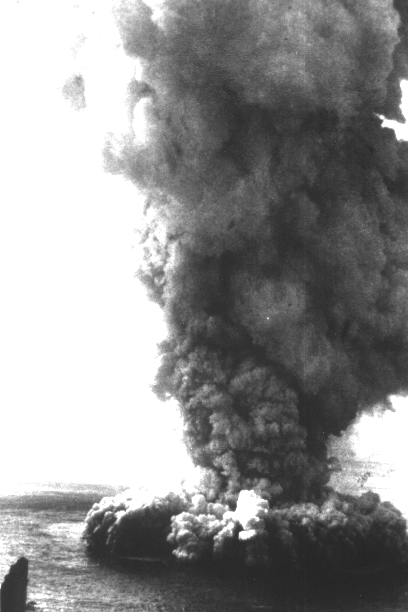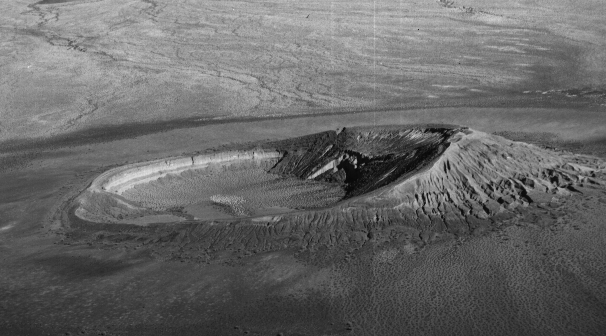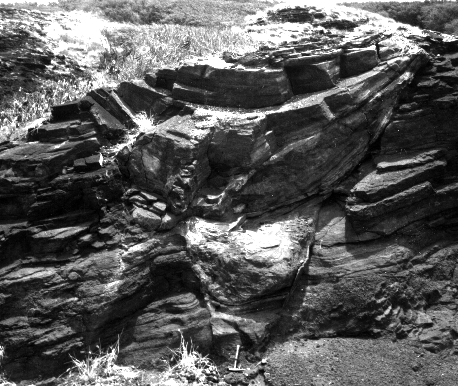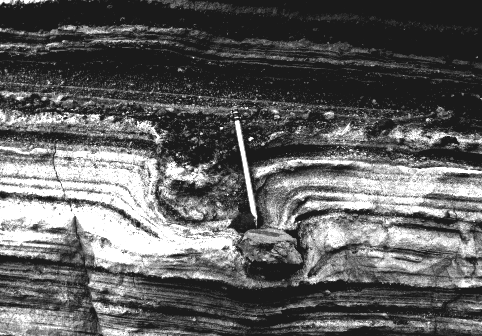
 Photograph of Cerro Colorado volcano, Pinacate Volcanic Field, northern Mexico. Cerro
Colorado is a maar volcano with a broad crater and low rims formed by
hydrovolcanic processes.
Prevailing winds blew toward the southwest at the time of eruption to form
the high point of the rim.
Photograph of Cerro Colorado volcano, Pinacate Volcanic Field, northern Mexico. Cerro
Colorado is a maar volcano with a broad crater and low rims formed by
hydrovolcanic processes.
Prevailing winds blew toward the southwest at the time of eruption to form
the high point of the rim.
A volcanically produced base surge was recognized during the 1965 phreatomagmatic eruption of Taal Volcano, Philippines (Moore, 1967). Base surges are composed of turbulent mixtures of water vapor or condensed droplets and solid particles. The surge may initially be dry if the water is vaporized, but during transport, if the water condenses, the mixture will become wet with water droplets mixed with particles coated with thin water films. Upon deposition, surface tension of water cohesively bonds the particles and causes the deposit to behave plastically.
Base surge deposits are moderately to poorly sorted, decreasing in grain size and thickness logarithmically away from the source, with local thickness controlled by topography. The deposits commonly display sedimentary structures resembling nonvolcanic structures but are unique to volcanic deposits. Base surge deposits commonly extend <3km from their source.
Hydroclastites are commonly composed of vitric shards, crystals and lithic fragments. Vitric shards from hydroclastic eruptions are characteristically blocky, with equant shapes and fracture-bounded surfaces transsecting sparse vesicles. Blocky mafic shards (sideromelane) form a large percentage of deposits of maar volcanoes and littoral cones. Vesicular shards are also present where vesiculating magma was quenched by water or steam. These deposits may clasts intermediate between blocky fragments and those that are slightly vesicular with scalloped edges to highly vesicular clasts.
Surfaces of many lapilli and bombs from hydroclastic eruptions have an irregular cracked structure variously described as cauliflower, crackled or bread crust. This texture resembles that of bread crust bombs, but forms by thermal contraction rather than from internal gas expansion. Cauliflower bombs are commonly dense.
Accretionary lapilli are common in many hydroclastic layers due to abundant water and steam in the eruption column occuring in conjunction with abundant fine-grained tephra.
"Convolute laminations" are a common type of soft sediment deformation consisting of folded beds between undeformed layers that may be several centimeters thick and may extend laterally for several meters. These form by gravity sliding of sloping water-saturated tephra or from shear-deformation caused by an overriding pyroclastic surge.
Vesicles, common in base surge beds (Lorenz, 1974), are generally subspherical, with smooth interior walls coated by very fine-grained ash. Large voids (up to 1 cm) commonly have irregular shapes and consist of several coalesced bubbles. Vesicles are most common in beds with soft sediment deformation structures, but also occur in lahars, in tuff beds with mud cracks, and even in tuff plastered on vertical surfaces. Many tuff beds with vesicles contain accretionary lapilli which themselves may contain small vesicles. Gases responsible for the vesicles may be: (1) from the gaseous phase of the depositing system, (2) given off by hot pyro- and hydroclasts, (3) air rising from the underlying ground, or (4) from water evaporating from snow or water-soaked soil beneath a layer of hot ash. Still another source may be (5) rain that turns to steam as it percolates downward into hot ash.
Wave lengths of dunes at about 1 km from the explosion center at Taal volcano attained 19m, and decreased systematically to about 4m at 2.5 km from the crater center (Waters and Fisher, 1971). The dunes migrated away from explosion center as indicated by orientation of internal laminations and shape of dune crests (Moore, 1967). Low dips of foreset (lee-side) laminations (10 to 15 degrees) indicate that dunes advanced by flow entrainment of particles rather than gravitational rolling of loose debris. Wave lengths of the Taal dunes vary directly with total thickness of the deposit, bedding thickness, size parameters of ash and the distance from the source, suggesting that the carrying capacity decreased progressively with distance as velocity slowed.
Cross beds in base surge deposits change laterally from very large dune-like structures near the source to smaller more subdued dunes. Still farther, dunes grade into plane parallel beds. These downcurrent changes suggest that the bed load was dropped rapidly near the source and the energy of transport or capacity to carry a load then decreased more slowly (Schmincke et al., 1973).
Reverse grading of plane parallel beds suggests lateral mass transport and deposition by non-turbulent flow as is the case for lahars. This is especially evident in beds where large blocks rest on lower contacts without significant deformation indicating emplacement by flow. They are deposited from rather sluggish, cool pyroclastic flows.

U-shaped channels in base surge deposits have broad curving bottoms and clearly cut underlying layers, and in cross section commonly measure from 0.3m width and 0.2m depth. Infilling beds reflect the shape of the channels, but the curvature of individual beds decrease upward (beds thicken toward centers of channels). Thus, the upper beds in the channels extend uniformly across the channel conformably with the sequence above and outside the channel. The U-shape of channels is believed to be caused by lobate geometry of advancing density currents (Fisher, 1977). The fronts of density currents consist of lobes separated by clefts that spread outward from the source. Moving down a widening slope of a volcano, individual lobes diverge to follow independent paths and carve diverging furrows straight down the slope. The concentration of particles within the lobes is probably greatest along their central axes, where boundary effects are least and velocity is greatest.

Bedding sags form by the impact of ballistically ejected bombs, blocks and lapilli upon beds capable of being plastically deformed. They are common in hydroclastic deposits of many maar volcanoes, tuff rings and tuff cones. Beds beneath the fragments may be completely penetrated, dragged down and thinned, folded, or show micro-faulting (Heiken, 1971). Deformation is commonly asymmetrical, showing the angle and direction of impact if three-dimensional exposures are available. These differ from dropstones in glacial environments in that dropstones fall perpendicular to the bottom, symmetrically indenting bedding and rarely, if ever, penetrating.
Crowe, B.M. & Fisher, R.V. (1973) Sedimentary structures in base-surge deposits with special reference to cross-bedding, Ubehebe Craters, Death Valley, California. Bull. geol. Soc. Amer. 84, 663-682.
Fisher, R.V. (1977) Erosion by volcanic base-surge density currents: U-shaped channels. Bull. geol. Soc. Amer. 88, 1287-1297.
Fisher, R.V. (1984) Submarine volcaniclastic rocks. In Kokelaar, B.P. and Howells, M.F. (eds), Marginal basin geology: volcanic and associated sedimentary and tectonic processes in modern and ancient marginal basins. Spec. Publ. geol. Soc. London 16, 5-27.
Fisher, R.V. & Schmincke, H.-U. (1984) Pyroclastic Rocks. Springer-Verlag, Berlin, 472 pp.
Fisher, R.V. & Schmincke, H.-U. (1994) Volcaniclastic sediment transport and deposition. In Pye, K. (ed.), Sediment Transport and Depositional Processes. Blackwell Scientific Publications, p. 351-388.
Heiken, G.H. (1971) Tuff rings: examples from Fort Rock-Christmas Lake Valley, south-central Oregon. J. Geophys. Res. 76, 5615-5626.
Heiken, G. & Wohletz, K. (1985) Volcanic ash. Berkeley, University of California Press, 1-246.
Lorenz, V. (1974) Vesiculated tuffs and associated features. Sedimentology 21, 273-291.
Moore, J.G. (1967) Base surge in recent volcanic eruptions. Bull. Volcanol. 30, 337-363.
Schmincke, H.-U., Fisher, R.V. & Waters, A.C. (1973) Antidune and chute and pool structures in the base surge deposits of the Laacher See area, Germany. Sedimentology 20, 553-574.
Self, S., Kienle, J. and Huot, J.P. (1980) Ukinrek Maars, Alaska, II. Deposits and formation of the 1977 craters. J. Volcanol. Geotherm. Res. 7, 39-65.
Sheridan, M.F. & Updike, R.G., 1975. Sugarloaf Mountain tephra - - a Pleistocene rhyolitic deposit of base-surge origin. Bull. geol. Soc. Amer., 86, 571-581.
Sigurdsson, H., Carey, S.N. & Fisher, R.V. (1987) The 1982 eruptions of El Chichón volcano, Mexico (3): Physical properties of pyroclastic surges. Bull. Volcanol. 49, 467-488.
Valentine, G.A. (1987) Stratified flow in pyroclastic surges. Bull. Volcanol. 49, 616-630.
Walker, G.P.L. (1984) Characteristics of dune-bedded pyroclastic surge bedsets. J. Volcanol. Geotherm. Res. 20, 281-296.
Waters, A.C. & Fisher, R.V. (1971) Base surges and their deposits: Capelinhos and Taal Volcanoes. J. geophys. Res. 76, 5596-5614.
Wohletz, K.H. (1983) Mechanisms of hydrovolcanic pyroclastic formation: grain-size, scanning electron microscopy, and experimental studies. J. Volcanol. Geotherm. Res. 17, 31-63.
Wohletz, K.H. (1986) Explosive magma-water interactions: Thermodynamics, explosion mechanisms, and field studies. Bull. Volcanol. 48, 245-264.